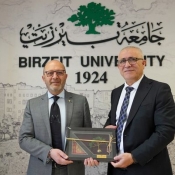Study Launched on Obstacles to Women's Labor Participation
On October 30, 2013, Birzeit University Center for Development Studies and the Young Women's Christian Association (YWCA), held a workshop to launch the study: "The Obstacles to women's participation in the labor market and entrepreneurship in the occupied Palestinian territories."
Vice President for Community Outreach Samia Hlaileh emphasized the importance of partnership between the YWCA Federation - Palestine and Birzeit University.
Minister of Women's Affairs Rabiha Diab noted that the percentage of women working in the public sector is much higher than other sectors, emphasizing the need to support women to integrate into the labor market, despite all the political, social and economic obstacles.
Minister of Labor Ahmed Magdalany told the group that in recent years, the rate of Palestinian women’s participation in the labor market has significantly risen from 14% to about 17% of the overall labor market. Magdalany added that basic obstacles to their participation are manifested in women’s education that is mainly in traditional services, health and educational sectors, and not in the highly advanced sectors where there is more demand in the labor market.
President of the YWCA Federation in Palestine Abla Nasir gave a briefing on the history of the YWCA, explaining that its scope of work is based on four key areas: economic justice; empowerment of women in the economic sector; supporting women's rights and building youth leadership.
CDS director Samia Butmeh presented the study and its results, reiterating that the women's unemployment rate is increasing but that women's scope of work is restricted to the services, agricultural and educational sectors.
The study featured at the event highlighted the lack of appropriate educational outcomes that meet market needs, and the absence of factors encouraging women's participation in the labor market.
The study confirmed that the political situation is the main obstacle to economic development and this impacts employment. Also, the barriers, closure of cities, the wall and by-pass roads are major obstacles to accessing the labor market and to investment projects.






